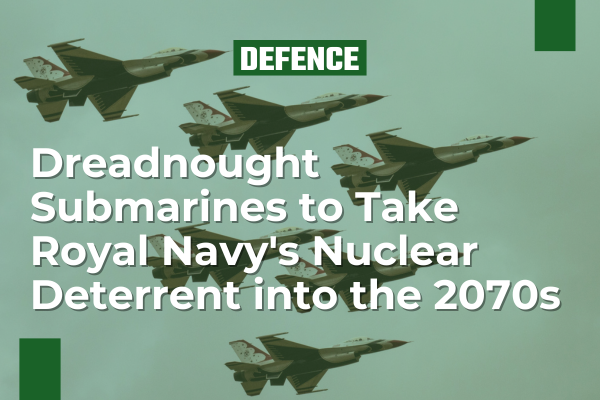
Dreadnought Submarines to Take Royal Navy's Nuclear Deterrent into the 2070s
04 Apr, 20252 minsA New Era for Britain's Nuclear DefenceThe Royal Navy is preparing to usher in a new chapter...

A New Era for Britain's Nuclear Defence
The Royal Navy is preparing to usher in a new chapter in its Continuous At Sea Deterrent (CASD) programme with the introduction of the Dreadnought-class submarines, set to replace the ageing Vanguard fleet.
For over half a century, the Royal Navy has maintained an unbroken at-sea deterrent patrol, but the current submarines carrying the UK's nuclear warheads are approaching the end of their operational lifespans.
The Dreadnought-class submarines will soon take up this critical role, continuing the UK's nuclear mission that began in the 1960s.
Impressive Specifications
These formidable vessels will stretch more than 150 metres in length and carry the Trident II D5 ballistic missiles. Each submarine will have a displacement of 17,000 tonnes and feature innovative X-rudders specifically designed to minimise underwater noise detection.
Perhaps most remarkably, these new submarines are expected to remain in active service for 35 to 40 years – significantly outlasting their predecessors.
Timing Challenges
Despite the pressing need for replacement vessels, the first of the four Dreadnought submarines isn't anticipated to enter service until the 2030s.
The Vanguard class, which first entered service in the 1990s, was originally designed with a service life of approximately 25 years. That timeline has long since passed, yet all four boats remain operational. HMS Vanguard itself was initially scheduled to retire in 2024.
Construction of the new class is underway at Barrow-in-Furness in Cumbria, with the first steel cut for HMS Dreadnought taking place back in 2016 – merely two years before HMS Vanguard was originally due to be decommissioned.
Significant Investment
The total cost of the project stands at £41 billion, including £31 billion (adjusted for inflation) for development and production, plus an additional £10 billion set aside for contingencies.
Further investment will also be required for shore-based infrastructure, including essential upgrades at HM Naval Base Clyde (Faslane) to accommodate these larger submarines.
This represents a substantial financial commitment during a period when defence budgets are under considerable strain. The government has committed to increasing defence spending to 2.5% of GDP by 2027 – a policy that may alleviate some of this pressure.
However, much of that additional funding is already earmarked for supporting Ukraine in its ongoing land war against Russia.
Strategic Necessity
With Russia and China both continuing to invest heavily in their conventional and nuclear forces – and with growing threats to undersea infrastructure and increasingly frequent incursions by Russian naval vessels near
UK waters – a question emerges: Can the Royal Navy afford not to invest in its continuous at-sea deterrent?
The Dreadnought-class will replace a fleet already operating beyond its expected lifespan, securing the UK's strategic deterrent capability into the 2070s – a capacity that has underpinned the nation's defence strategy for decades.
Talent and Workforce: The Human Element
The Dreadnought programme represents not only a significant technological challenge but also a crucial investment in British talent and skills. The project is creating and sustaining thousands of highly skilled jobs across the UK, particularly in Barrow-in-Furness, which was recently granted royal status in recognition of its submarine-building heritage.
BAE Systems, the primary contractor, has established dedicated training academies and apprenticeship programmes specifically to develop the next generation of submarine engineers and technicians. These initiatives are addressing the critical skills gap in advanced manufacturing and engineering, ensuring Britain maintains sovereign capability in this strategically vital sector.
The complexity of nuclear submarine construction requires expertise across numerous disciplines – from nuclear engineering and advanced materials science to sophisticated digital systems integration. Many of these skills are transferable to other high-tech industries, creating a positive ripple effect throughout the UK economy.
For the Royal Navy, the human element extends beyond construction to operation. The service must recruit, train and retain the highly specialised personnel needed to crew these vessels. Each Dreadnought submarine will require approximately 130 crew members, all requiring extensive training in their specialist roles. The Navy's Submarine Service faces the ongoing challenge of attracting sufficient talent to maintain operational readiness while competing with private sector opportunities.
This focus on talent development underscores the Dreadnought programme's importance beyond military capability – it represents a significant national investment in human capital and advanced skills that will benefit British industry for decades to come.


